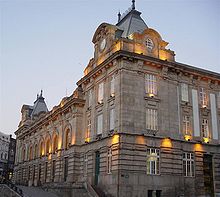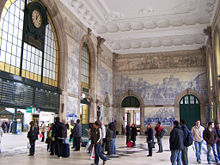
São Bento Train Station
Encyclopedia

Porto
Porto , also known as Oporto in English, is the second largest city in Portugal and one of the major urban areas in the Iberian Peninsula. Its administrative limits include a population of 237,559 inhabitants distributed within 15 civil parishes...
, in Portugal
Portugal
Portugal , officially the Portuguese Republic is a country situated in southwestern Europe on the Iberian Peninsula. Portugal is the westernmost country of Europe, and is bordered by the Atlantic Ocean to the West and South and by Spain to the North and East. The Atlantic archipelagos of the...
. Inaugurated in 1916, the historical station is known for its tile
Tile
A tile is a manufactured piece of hard-wearing material such as ceramic, stone, metal, or even glass. Tiles are generally used for covering roofs, floors, walls, showers, or other objects such as tabletops...
(azulejo
Azulejo
Azulejo from the Arabic word Zellige زليج is a form of Portuguese or Spanish painted, tin-glazed, ceramic tilework. They have become a typical aspect of Portuguese culture, having been produced without interruption for five centuries...
) panels that depict scenes of the History of Portugal
History of Portugal
The history of Portugal, a European and an Atlantic nation, dates back to the Early Middle Ages. In the 15th and 16th centuries, it ascended to the status of a world power during Europe's "Age of Discovery" as it built up a vast empire including possessions in South America, Africa, Asia and...
. It is located in the Almeida Garret Square, in the centre of the city. It remains in regular use as a railway station, served by trains operated by Comboios de Portugal
Comboios de Portugal
thumb|250px|right|CP suburban trains at São Bento Station in Oporto.CP — Comboios de Portugal, EPE is a state-owned company which operates freight and passenger trains in Portugal...
.
History
The name of the station derives from a BenedictineBenedictine
Benedictine refers to the spirituality and consecrated life in accordance with the Rule of St Benedict, written by Benedict of Nursia in the sixth century for the cenobitic communities he founded in central Italy. The most notable of these is Monte Cassino, the first monastery founded by Benedict...
monastery built on this spot in the 16th century. The monastery fell victim of a fire in 1783, was later rebuilt, but was in a grave state of disrepair at the end of the 19th century. In the context of an expansion of the railway system in Portuguese territory, King Carlos I
Carlos I of Portugal
-Assassination:On 1 February 1908 the royal family returned from the palace of Vila Viçosa to Lisbon. They travelled by train to Barreiro and, from there, they took a steamer to cross the Tagus River and disembarked at Cais do Sodré in central Lisbon. On their way to the royal palace, the open...
laid the first stone of the station in 1900. The project was entrusted to Porto architect José Marques da Silva
José Marques da Silva
José Marques da Silva was a portuguese architect .-Training:José Marques da Silva was born at 113 Rua de Costa Cabral, in Porto, on 18 October 1869. His architectural training began at the Porto Academy of Fine Arts, where his teachers were, among others, António Geraldes da Silva Sardinha,...
, who designed a building under the influence of French
French architecture
The history of French architecture runs in parallel with its neighbouring countries in Europe, with France being home to both some of the earliest pioneers in many architectural styles, and also containing some of the finest architectural creations of the continent.-Roman:The architecture of...
Beaux-Arts architecture.

Tiles
The most notable aspect of São Bento Station are the large, magnificent tileTile
A tile is a manufactured piece of hard-wearing material such as ceramic, stone, metal, or even glass. Tiles are generally used for covering roofs, floors, walls, showers, or other objects such as tabletops...
panels in the vestible. The tiles number 20 thousand, date from 1905–1916 and are the work of Jorge Colaço
Jorge Colaço
Jorge Colaço was a Portuguese painter specially known for his works as tile painter.Jorge Colaço was born in Tangier, Morocco, the son of a Portuguese diplomat...
, the most important azulejo
Azulejo
Azulejo from the Arabic word Zellige زليج is a form of Portuguese or Spanish painted, tin-glazed, ceramic tilework. They have become a typical aspect of Portuguese culture, having been produced without interruption for five centuries...
painter of the time.
The panels depict landscapes, ethnographic scenes as well as historical events like the meeting of knight Egas Moniz and Alfonso VII of León
Alfonso VII of León
Alfonso VII , born Alfonso Raimúndez, called the Emperor , became the King of Galicia in 1111 and King of León and Castile in 1126. Alfonso first used the title Emperor of All Spain, alongside his mother Urraca, once his mother vested him with the direct rule of Toledo in 1116...
(12th century), the arrival of King John I
John I of Portugal
John I KG , called the Good or of Happy Memory, more rarely and outside Portugal the Bastard, was the tenth King of Portugal and the Algarve and the first to use the title Lord of Ceuta...
and Philippa of Lancaster
Philippa of Lancaster
Philippa of Lancaster, LG was a Queen consort of Portugal. Born into the royal family of England, her marriage with King John I secured the Anglo-Portuguese Alliance and produced several famous children who became known as the "Illustrious Generation" in Portugal...
in Porto (1387) and the Conquest of Ceuta
Battle of Ceuta
The Battle of Ceuta and the subsequent conquest of the Wattasid city of Ceuta by the Portuguese had its roots in the earliest years of the House of Aviz dynasty of Portugal...
(1415).

